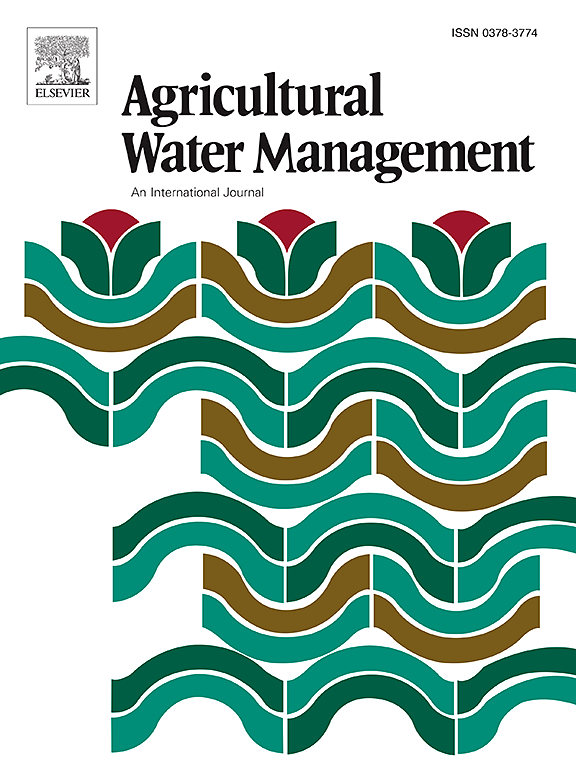Analysis of changes in water-heat-carbon fluxes at different time scales and their influencing factors in the cold black soil region of Northeast China
IF 6.5
1区 农林科学
Q1 AGRONOMY
引用次数: 0
Abstract
The changing characteristics of water-heat-carbon fluxes and their relationship with environmental influencing factors are crucial for understanding food security and achieving 'carbon peak' and 'carbon neutrality' in a changing climate. Utilizing the measured data from the study area, this study incorporated temperature coefficients to improve the Lloyd-Taylor model. Subsequently, the patterns of change in water-heat-carbon fluxes and environmental factors were analyzed across different time scales. The partial least squares structural equation model (PLS-SEM) was employed to calculate the direct and indirect effects of water-heat-carbon fluxes and environmental factors on one another. The findings indicate the following: (1) During the crop growth periods in the maize growing area, the daily mean value of net ecosystem carbon exchange (NEE) was measured at −1.46 μmol/m²/s, signifying a significant carbon sink. In contrast, during the freezing-thawing periods, the daily mean value of NEE was recorded at 0.23 μmol/m²/s, indicating a marginal carbon source. Overall, the annual carbon balance resulted in a carbon sink of 242.2 gC/m²/y, categorizing the entire ecosystem as a carbon sink. (2) Sensible heat flux (H) is negatively correlated with latent heat flux (LE) and evapotranspiration (ET) during the reproductive period at both daily and monthly scales but positively correlated with ET during other time scales. Environmental factors at the full-hourly-scale indirectly influenced ET by directly affecting H. (3) Air temperature (Ta), soil surface temperature (Ts), and the difference in saturated water vapor pressure (VPD) consistently demonstrated significant positive effects on ecosystem respiration (Reco), while Rn consistently exhibited substantial positive effects on ecosystem gross primary production (GPP). (4) Reco consistently exerted a significant direct positive effect on NEE, while GPP consistently demonstrated a significant direct negative effect on NEE. Environmental factors substantially impacted the carbon flux components, indirectly influencing farmland ecosystems' carbon sequestration capacity in the cold black soil region. These findings enhance our understanding of how water-heat-carbon fluxes respond to environmental factors and can provide theoretical support for coupled hydrothermal carbon modeling. This knowledge is crucial for assessing and predicting the responses of cropland ecosystems in the cold black soil Region to ongoing climate change.
东北寒冷黑土区不同时间尺度水-热-碳通量变化及其影响因素分析
水-热-碳通量的变化特征及其与环境影响因子的关系对于理解气候变化下的粮食安全以及实现“碳峰值”和“碳中和”至关重要。本研究利用研究区域的实测数据,加入温度系数来改进Lloyd-Taylor模型。在此基础上,分析了不同时间尺度的水-热-碳通量和环境因子的变化规律。采用偏最小二乘结构方程模型(PLS-SEM)计算了水-热-碳通量与环境因子之间的直接和间接影响。结果表明:(1)玉米种植区作物生育期净生态系统碳交换(NEE)日平均值为- 1.46 μmol/m²/s,存在显著的碳汇。冻融期NEE的日平均值为0.23 μmol/m²/s,属于边际碳源。总体而言,年碳平衡导致了242.2 gC/m²/y的碳汇,将整个生态系统归类为碳汇。(2)生殖期感热通量(H)在日和月尺度上与潜热通量(LE)和蒸散发(ET)呈负相关,在其他时间尺度上与ET呈正相关。(3)气温(Ta)、土壤表面温度(Ts)和饱和水汽压差(VPD)对生态系统呼吸(Reco)的正向影响持续显著,而湿度(Rn)对生态系统初级生产总值(GPP)的正向影响持续显著。(4) Reco对NEE的直接正向影响持续显著,GPP对NEE的直接负向影响持续显著。环境因子对寒黑土区农田生态系统碳通量组分有较大影响,间接影响农田生态系统固碳能力。这些发现增强了我们对水-热-碳通量对环境因子响应的认识,并为热液碳耦合模型的建立提供了理论支持。这些知识对于评估和预测寒冷黑土地区农田生态系统对持续气候变化的响应至关重要。
本文章由计算机程序翻译,如有差异,请以英文原文为准。
求助全文
约1分钟内获得全文
求助全文
来源期刊

Agricultural Water Management
农林科学-农艺学
CiteScore
12.10
自引率
14.90%
发文量
648
审稿时长
4.9 months
期刊介绍:
Agricultural Water Management publishes papers of international significance relating to the science, economics, and policy of agricultural water management. In all cases, manuscripts must address implications and provide insight regarding agricultural water management.
 求助内容:
求助内容: 应助结果提醒方式:
应助结果提醒方式:


